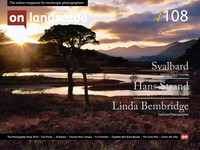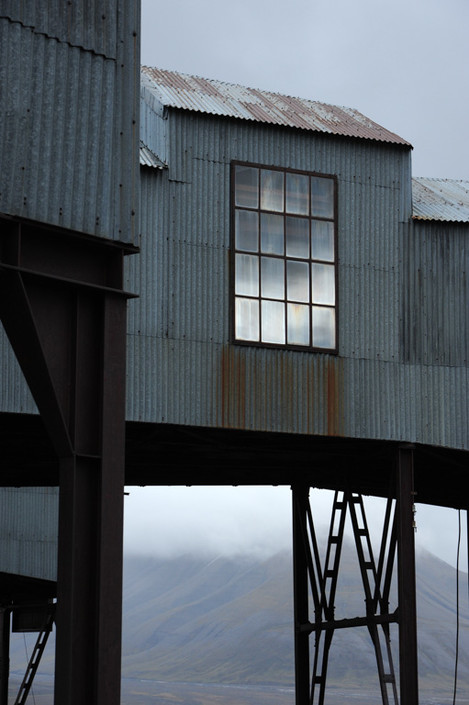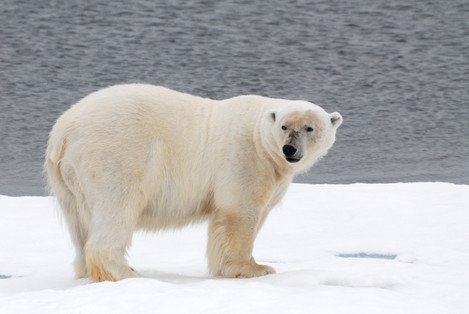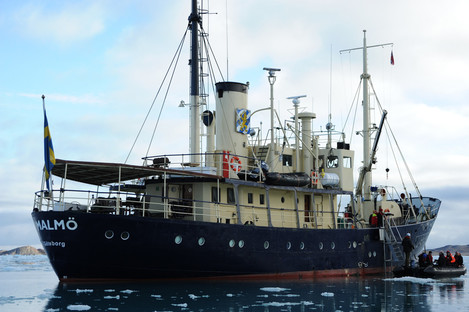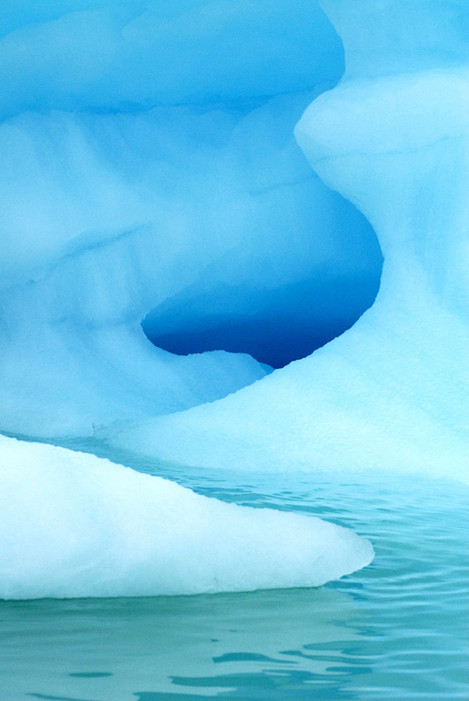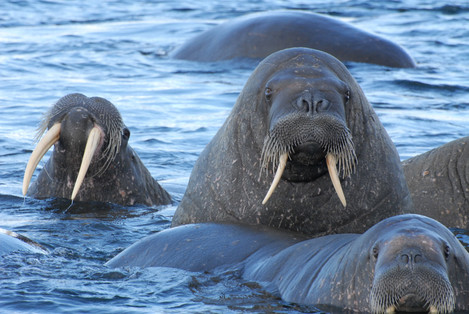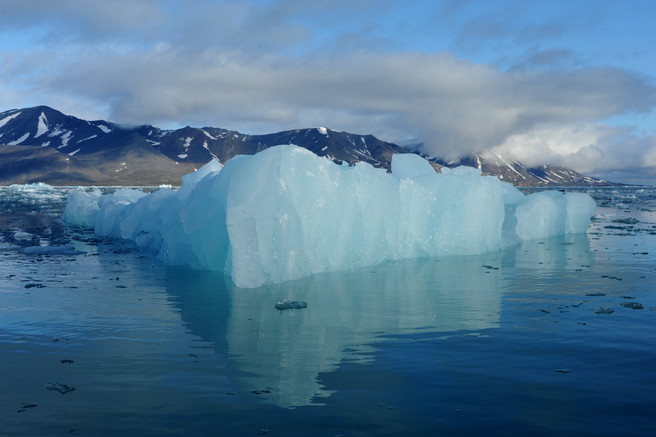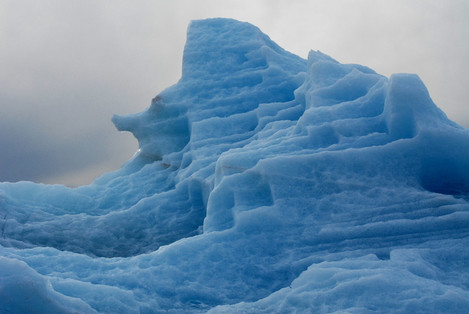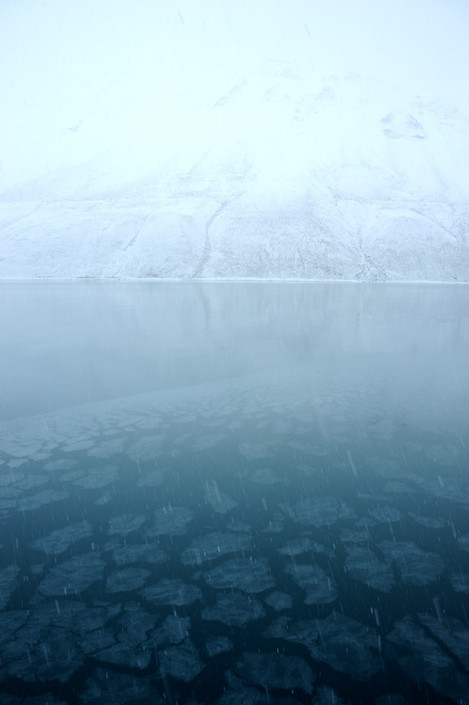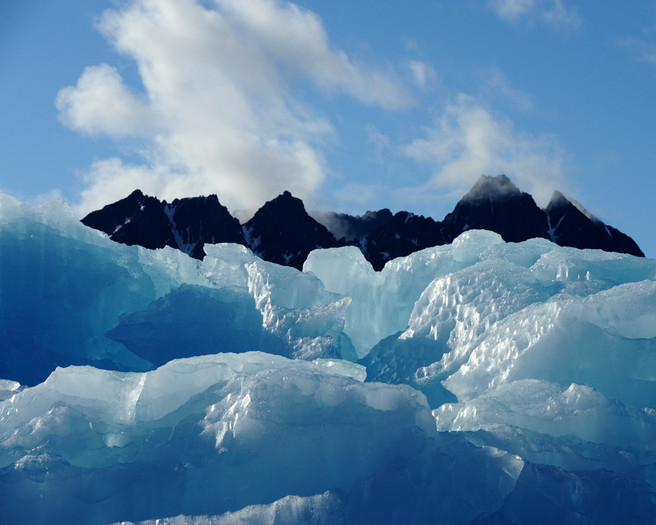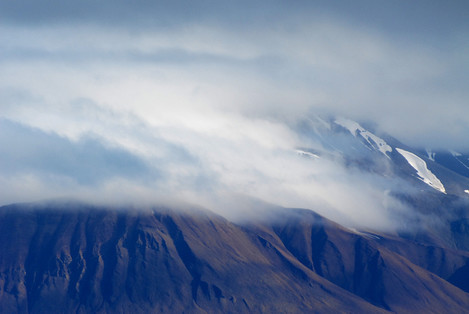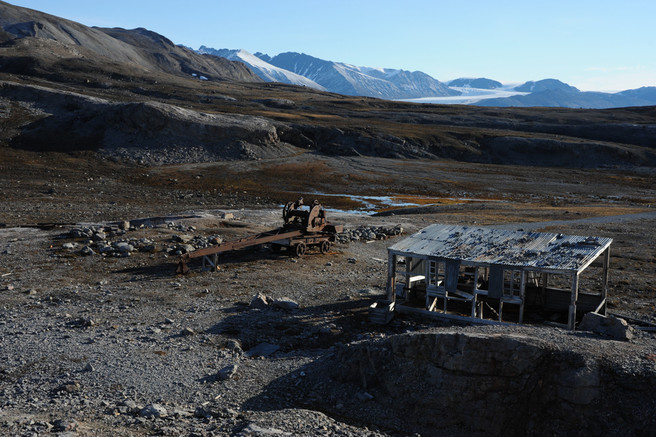Harvey Lloyd-Thomas writes about his trip to Svalbard

Harvey Lloyd-Thomas
A photographer who enjoys exploring wilder and remoter landscapes, searching out unseen details, while attempting the occasional photographic vista. Also partial to the odd image of rust and decay
Introduction
The Svalbard archipelago - formerly known as Spitsbergen - high in the Arctic, is somewhere I've long wanted to visit. It is not clear when Svalbard was first discovered, was it the mysterious land of Thule written of by the Greeks? Was it even the cold shores recorded by the Norse from which Svalbard gets its name? What is certain is the sighting in 1596 of pointed mountains which translates as Spitsbergen, by the Dutch sailor Barents.
Historically Svalbard became know as a whaling base, in more recent times for coal mining and today tourism is on the rise. Politically Svalbard has had a unique status since a 1925 treaty ceded the lands to Norway, but retaining a Russian presence (illustrated by Vodafone sending me a welcome to Russia text as we sailed past the mouth of the fjord containing the Russian mining settlement of Barentsburg, then shortly after welcoming me to Norway as we neared Longyearbyen). Today Svalbard mainly makes the news for polar bear attacks (fortunately a rare occurrence) and the Doomsday seed vault buried in the permafrost.
While I must have seen Svalbard on maps before, I first remember reading about the archipelago in the Time-Life Photography Year 1974/75 book, which was in the art rooms during my time in the sixth form back in the 80s. The book included a feature on the then new phenomenon of photo safaris and the first such voyage to Svalbard. Subsequently I heard about and saw photos from a trekking holiday a friend made to the islands back in the 90s. So in 2014 when the opportunity arose to sign-up for a photo safari to Svalbard in the summer of 2015 aboard the MS Malmö, it was an opportunity - despite the expense - I felt I could not pass on. It would round off my exploration of North Atlantic islands and further north into the Arctic Circle, having previously visited the Shetland Islands, the Faroe Islands, Iceland, east Greenland and northern Norway.
The stated focus of the trip was to encounter and photograph polar bears. So what opportunities might there be for an outdoor/landscape photographer such as myself? While I'm always thrilled to observe rarely seen animals in the wild, I don't have the patience and/or perseverance to do them justice photographically, therefore, what follows is a non-wildlife photographer's viewpoint of ostensively a wildlife photography expedition.
Getting There
My Arctic adventure began when I found myself catching a coach at an unpleasantly early hour to join the crowds and queues at Heathrow. Despite its seemingly remote location Svalbard is surprisingly easy to get to, with scheduled flights from mainland Norway to the northernmost airport in the world. I had an overnight stop at Oslo and then a cloudy afternoon arrival into the main settlement of Longyearbyen, flying via Tromsø. I then had two nights in Longyearbyen to acclimatise, before I was to join the ship.
Longyearbyen
Longyearbyen is named after the American John Munro Longyear whose mining company founded the settlement and although colourful is not a particularly pretty place, it is functional and possibly looks better in snow. In the absence of snow, rows of snowmobiles lie parked-up for the summer and Norwegian flags fly aplenty. The skyline is dominated by the derelict wooden pylons of aerial cableways which once carried coal down from the now defunct mines in the mountainsides above.
I spent a leisurely day of broken low cloud with intermittent shafts of light, on and off rain and rainbows, exploring the town on foot. Including a walk up to the old cableway junction building for a dose of dereliction photography. I also spent time browsing outdoor gear shops, drinking coffee and eating cake. While there are plenty of opportunities to buy polar bear themed souvenirs, I instead purchased a pair of neoprene wellies as my more practical souvenir to be worn in the days ahead.
The Voyage
Three days after first setting out I finally joined the ship which was to be my home for the next ten nights. The MS Malmö is one of the smaller ships cruising in Svalbard's waters and having been built in 1943 probably the oldest (with a marine patina to match). With a crew of only eight and on this voyage 12 passengers, it was dwarfed by the modern cruise ship MS Fram moored nearby (37 metres versus 114 metres).
Day 1
We left dock late afternoon and with safety briefings completed headed out into Isfjorden. A heavy swell made me feel queasy during dinner, but I was to get my sea legs after a day or so and felt fine for the rest of voyage. Leaving Isfjorden we turned north into the shelter of Forlandsundet and I passed the evening on deck for fresh air and views of glaciers and mountains rising from the sea. Overnight we sailed north with a swell returning as we hit open water again.
Day 2
We breakfasted passing between the shelter of islands in the NW corner of the archipelago. The plan was to head NE towards the last reported position of the closest sea ice: the natural habitat of the polar bear. Ever present fulmars following the ship, soaring just above the water, with cloud covering the coast. Lunch. Dinner. Sleep. To await a weather window in which to reach the ice, we entered Duvefjorden along the northern coast of Nordaustlandet.
Day 3
Bear alert! A knock on the cabin door in the early hours alerted us to the sighting of the first polar bear of the trip on shore at the head of the fjord. A distant sighting and the bear soon wandered off. Back to bed. After breakfast our first zodiac cruise exploring two glacier fronts. With feeding kittiwakes, black guillemots and some seals. Lunch at anchor. We then up anchor and headed out for the pack ice, but further bears were spotted along a small area of remaining fast ice against the shore and so down anchor and into the zodiacs. One female spooked by us who kept her distance, plus a mother and cub, not bothered by our presence. The mother sitting patiently over a seal's breathing hole: waiting. We also waited, watching the bears for an hour or so. Returning to the ship, we finally headed out towards the last known position of sea ice while the weather window held. Again woken in the early hours with two bears spotted on the ice with the remains of a fresh seal kill. The bears were not particularly bothered by the ship, which manoeuvred around them for an hour or so. With the wind getting up we then headed towards Sjuøyane [Seven Islands] for shelter.
Day 4
Reached Sjuøyane for breakfast and I spotted my first walrus in the water. After lunch a landing on the nearby island of Phippsøya and a hike in the rain over a col to a beach where walruses had been seen hauled out, but by the time we approached they had re-entered the water, so we retraced our steps. Overnight at anchor in the shelter of the islands awaiting a weather update in the morning.
Day 5
Day 6
After a choppy overnight passage north we reached the edge of the ice before breakfast and cruised west along its southern extent, with excursions into the pack to stop and drift and wait for inquisitive bears. Weather sunny. In the distance I saw one bear during the morning and one bear in the afternoon (further bears were seen by others), however, none came close up to the ship. Kittiwakes about and some seals in the water. A calm and - with the engine shutdown - quiet night drifting within the ice.
Day 7
By morning the ice was more thinned and broken-up and with visibility lower at times conditions were becoming less favourable for spotting any more bears. So we headed south for a 16 hour passage to the NW fjords. Land sighted to the south before I went to bed and a blue whale then spotted shortly after I had retired!
Day 8
Awakened by the sound of ice against the hull. Anchored in Liefdefjorden where we took zodiac cruises around fantastically sculpted blue icebergs. Landed on a newly exposed islet at the front of the receding Monacobreen. Got close to a bearded seal on an ice slab. After lunch headed back out to the mouth of the fjord anchoring near Andøyane [Bird Islands] where hundreds of birds were feeding on the water. Shortly after landing two sleeping bears spotted (turned out to an adult female in the company of an adult male, most unusual in summer) and so we retreated to the zodiacs and approached the bears again by water. Up anchor and headed around to the west for an overnight passage south.
Day 9
Arrived off Ny London for breakfast, in Kongsfjorden opposite the scientific research station of Ny-Ålesund. A fresh sprinkling of snow on the surrounding mountain tops. Went ashore to explore and photograph remains of the abandoned settlement associated with a failed marble quarry, established by British speculators in the first half of the twentieth century, hence the name Ny London. Reindeers spotted on the hillside above. Returned to the ship and we moved further up the fjord to the known location of Arctic fox dens. During lunch a fox was spotted and we went ashore. Fox cubs were seen at a distance and the mother came close, feeding on a reindeer carcass on the beach. Leaving the foxes we attempted to approach the stunning blue ice wall of Kongsbreen, but the water was too jammed with brash ice. So we landed again and hiked some way up the lateral moraine of the glacier (coming across bear footprints). Returning to the ship we moved anchorage and after dinner headed out into Forlandsundet and then south overnight.
Day 10
Still underway at breakfast. Swell building and now raining after a week of generally fine weather. Into our final anchorage of Trygghamna [Safe Haven] late morning. Fresh snow on the surrounding hills down to sea level, with the rain turning to snow and freezing as it hit the water around the ship, forming plates of ice. After lunch I forgoed a zodiac cruise in search of wildlife and stayed on board for photography of the now snow covered mountains surrounding the head of the fjord, plus fulmar versus jellyfish action. Later, we up anchor and headed out into Isfjorden. Reaching Longyearbyen by evening to take on much needed fresh water (people had been taking too many showers early on in the voyage) and so spent our final night aboard alongside.
Day 11
We disembarked after breakfast for a final morning around Longyearbyen, now raining with an icy wind. A look around the museum gave a reminder of the tough life had by previous generations of whalers and then miners. I caught an early afternoon flight out of Longyearbyen then onward via Tromsø and Oslo, finally arriving home in the early hours, with the longest leg of the journey nearly being the queue for passport control upon arrival at Heathrow. Thankfully the following day was a Bank Holiday for a much needed lie-in!
(If flying via Tromsø be prepared for having to get off and then back on the same plane and the associated faff with luggage, as while Norway is in the Schengen area, Svalbard is not.)
Photography
Since I've returned I've looked at numerous images from Svalbard (on flickr etc.), but before I went I hadn't really seen or actively searched out that many. So I didn't have preconceived ideas of what images I wanted to come back with, other than being attracted by pictures of abandoned and now decaying mine buildings around Longyearbyen to satisfy my ruin lust! However, I think having previously visited east Greenland partly prepared me to an extent as to what to expect. Anyway, I don't plan my photography like some apparently do, apart from being drawn to what I think will be interesting destinations. Even then this is more about simply wanting to be in wild/remote places, by the coast or in the mountains, with photography then following from this desire.
Many - maybe most - of the landscape photos from my trip were not taken from the land, rather from either the ship or zodiacs. As it happens this shipborne photography suited an aspect of my personal photographic approach, in that I often use telephotos to isolate distant elements of the landscape. However, if you're after more traditional foreground interest, leading lines type images, finding such compositions from the deck of a ship can be challenging.
An advantage of shipborne sail-by-shooting is continually changing scenes and viewpoints, with the obvious downside that you can't necessarily take your time over a shot, especially when shooting from a zodiac. The main issue when photographing from zodiacs being the limited room and so having to be mindful of others as you jostle for position when framing subjects as your viewpoint is constantly changing. Having lenses and/or bodies with some sort of image stabilisation is also a boon to counter motion and vibrations.
On land limitations mainly came about from not being able to stray far from the group, because of the polar bear threat (with the constant reminder of rifles carried by the leaders). So those who prefer to wander off and explore alone (as I often do) can't. Obviously up at the edge of the sea ice extending north to the Pole, there wasn't even any actual landscape for a landscape photographer to photograph!
Visiting during summer meant 24 hour daylight and (to the eye at least) there wasn't much discernible difference in light levels between night and day.
Equipment
I adopted the KISS (Keep It Simple Stupid) approach to equipment and took (or not) the following kit:
- Nikon D700 FX full frame sensor DSLR primarily for landscapes.
- Nikon D200 DX cropped sensor DSLR primarily for wildlife (showing its age in terms of high ISO performance).
- Multiple batteries: type common to both D700/D200 plus charger plus spare charger.
- Nikkor AF 28-105mm f/3.5-4.5D zoom: solely used on the D700.
- Nikkor AF-S 70-300mm f/4.5-5.6G VR zoom: solely used on the D200 (105-450mm full frame equivalent reach when used on the DX body).
- Nikkor AIS 20mm f2.8 prime: not used. Had plans for using it for interiors of the ship.
- No filters, other than neutral/clear for protection on each lens.
- Tripod with ballhead: stayed in its bag the whole trip. Not really time to setup considered landscape compositions.
- All the CF cards I own, plus a few more bought prior to the trip in anticipation.
- No laptop for backing-up images or post-processing on the go. Treated full CF cards like we used to treat rolls of exposed film.
- GPS accessory which could be used with either camera to embed location information in EXIF data. Nice to have, although flickr sometimes doesn't appear to believe embedded EXIF data above 80 something degrees north when showing images, presumably some programmer decided data this far north must be in error!
I ended up using a mix of D700/D200 for landscape/wildlife depending upon which was to hand. On zodiac cruises and landings I'd make an educated guess as to what would be the predominate subject and just took a single body plus lens with me in a holster type camera bag (which was then placed in a dry bag).
I also own a Micro Four Thirds system, my reason for choosing the Nikon gear over MFT was that the Nikon gear had been previously tried and tested in harsh environments (having been used in winter conditions in Iceland and Lapland) and the larger Nikon bodies are far easier to use while wearing gloves. With the two bodies and two zoom lenses I hoped to minimise lens changes and in the event each lens stayed put on the respective body. I considered the D200 as backup for the D700 and vice versa.
Compared to others on the trip, I tried not to be too intimidated by everyone else having bigger lenses than myself!
Final Thoughts
Highlights of the trip:
- Being in the sea ice: the retrospective realisation of how precarious a position we potentially were in being less than 500 nautical miles from the North Pole in a 70 year old ship, literally off the chart and at the limits of rescue. At the time the isolation didn't worry me and I feel privileged to have been able to experience it. The vastness of the pack ice was only really brought home after seeing aerial drone footage from the trip.
- Polar bears on the ice after a kill: the dreamlike lasting impression of this encounter, possibly partly due to being woken in the night to witness the scene, then returning to my bunk and sleep afterwards.
- Clinking of brash ice in the water: sitting on a rocky islet in the sun, soaking in the views of the surrounding mountains, with the occasional interruption of distant rumbles as glaciers flowed.
So how did this wildlife trip work out for landscape photography? In the end the opportunities suited my spontaneous approach, where I'm happy shooting handheld, others who are tied to tripods and like to take their time over compositions may struggle. As for alternative ways of seeing Svalbard for a landscape photographer, there aren't many.
Pros and cons of big versus small ships:
- Bigger ships will offer more comfort and onboard facilities (and less likelihood of sea-sickness).
- In general trips aboard bigger ships will be cheaper, you pay for the exclusivity of smaller ships.
- Smaller ships mean smaller groups, generally giving the group more control over the itinerary.
- With bigger ships there are often not enough zodiacs for all passengers to take part in excursions and landings, you might have to wait your turn.
- Some smaller ships don't have the crew to maintain a 24 hour watch, limiting how far they can sail (no overnight passages possible).
- Not all ships are ice strengthened (which is not necessarily related to size) and so can't actually enter the pack ice as we did.
Finally, a recommendation for any future visitors, don't forget to sometimes forgo taking pictures and just appreciate where you actually are. Spend time just experiencing being there, rather than seeing everything through a viewfinder.
References
- Recommended reading: Andreas Umbreit, Svalbard (Spitsbergen), Bradt Travel Guide, 5th ed., 2013.
- Online resources: http://www.npolar.no/en/the-arctic/
- Video - including drone footage - shot by a professional cinematographer who was on the trip: https://vimeo.com/143968632
Acknowledgements
Multinational thanks to the expedition leaders Morten Jørgensen, Joshua Holko and Daníel Bergmann - Danish, Australian and Icelandic respectively - the Swedish crew of the MS Malmö and my British, Australian, Chinese, Russian and American fellow passengers.

